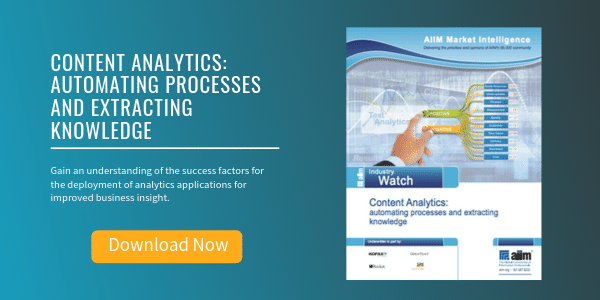
5 Obstacles to User Adoption of Content Analytics
As with any relatively new software application like Content Analytics, interest tends to be high, while progress is mixed. AIIM's independent research study on the topic garnered some interesting responses.
Consider the following stats from the study (Content Analytics: Automating Processes and Extracting Knowledge):
- A quarter of our respondents feel that they are stuck in a world of paper processes.
- 37% either have no one tasked to investigate, no mandate from above, or no budget to proceed (or a combination of these)
- For 23%, a start has been made, but progress is slow, or of mixed success.
- 11% are underway and encouraged by the results.
- 4% are already showing a return on their investment
What's leading to these mixed results? This same research helped us identify 5 common barriers to user adoption of content analytics. Let's take a look at each of these in greater detail.
- Definitions of what content analytics actually is are poorly understood and inconsistent.
- There is still too much focus on technology and not enough on business value; who truly are the buyers, influencers, and key stakeholders, and how are they different from those of yesteryear?
- The pace of technology change is accelerating and running ahead of the ability of organizations to consume it.
- We lack specific use cases.
- There is a splintering of data and data responsibility in the enterprise.
Obstacle #1 - Definitions of what content analytics actually is are poorly understood and inconsistent.
AIIM has defined content analytics in the following way:
“Content analytics is the act of applying business intelligence (BI) and business analytics (BA) practices to digital content. Companies use content analytics software to provide visibility into the amount of content that is being created, the nature of that content, and how it is used.”
Yet as with so many areas of technology, there is an on-going debate about the “true” meaning of content analytics. There is a lack of common language and concepts that can be used across organizations and industries, and often, if you asked people from different teams in the same organization about content analytics, you would get a different answer.
Ask an "ECM" person what they mean by "unstructured information" and you will get an answer focused on PDFs and application files and TIFF images. Ask a "Big Data" person, and you will get an answer focused on the data exhaust associated with the web and the internet of things."
This is something that must be addressed as a priority, but progress is undoubtedly being made as organizations focus less on the distinction between data and content and instead on outcomes. Traditional lines between data and content are blurring. No one cares about the distinction; they care about how information intersects with a business outcome.”
Obstacle #2 – There is still too much focus on technology and not enough on business value.
Who truly are the buyers, influencers, and key stakeholders, and how are they different from those of yesteryear?
Business outcomes from content analytics should be a higher priority than getting bogged down in technological jargon and slightly different interpretations of what content analytics is. Content analytics needs to be repositioned. It not only drives business decisions -- it is critical to business transformation. Organizations should be asking such questions as:
- Are our customers leaving? If so, why?
- If customers are staying, but assets are leaving, why?
- Where are the customers or assets going?
- What are the drivers?
- How do we get early and accurate detection?
- What do we do about it?
Monica Tolson, Assistant Director, BC Pension: “Use content analytics to inform your customer experience plan, keeping the focus on ease of use and seamless flow. The technology or platform doesn’t matter to users.”
Pamela Click, Divisional CIO - CSEB Technology, TIAA-CREF: “We don’t want a scanner, a database, or an application. People just want a button that does what they need. ROI and business case is critical in order to move forward, and it is often unclear.”
Jean Louis Arsenault, EVP of Sales and Marketing, Haystac: “Focus the value proposition on helping organizations understand they you have in a way that is repeatable, quantifiable, and defensible. No one asks for information governance, but they realize there is too much information and that they must decide what is really needed.”
Obstacle #3 - The pace of technology change is accelerating and running ahead of the ability of organizations to consume it.
The consumerization of IT makes it increasingly difficult for organizations to keep pace with that change. Knowledge workers are used to a level of technical performance in their home technology that is often not yet present in the workplace. We are in an era of “bimodal Content Management.” Mode 1 is focused on assuring information and process reliability. The real value is in Mode 2, creating business agility. It’s the difference between a marathon runner and a sprinter.
Pamela Click, Divisional CIO - CSEB Technology, TIAA-CREF: “Most of our customers don’t use our website or log in to their online account - instead, they rely on paper-based communication and phone. The technology is growing faster than the company can absorb.”
Thornton May: “One of THE most important outputs of content analytics might be matching content tools to content uses/users.”
Obstacle #4 - We lack specific use cases.
Demonstrating how and in what ways technology can help an organization is, of course, a key element in encouraging adoption. If organization A has achieved great success with content analytics, then organization B will want in on that. Unfortunately, content analytics does not inherently have a “killer app” in the way that other technologies do -- it is a catalyst to resolving business problems.
Theo Priestley, Technology Evangelist: “Organizations are not applying content analytics due to the industry creating segmented offerings. There are no practical examples of content-driven processes using content analytics as the automated trigger for decision making.”Jeremy Phillips, COO, EditorEye: “Collaboration is driven by content and is a key use case for content analytics. Content analytics is key to understanding the connection between topics (what people care about) and communities (how they interact with others).”
Mark Roboff, Executive Evangelist, IBM Watson: “We need to understand not just the problems that content analytics solves, but how it happens. Why is unstructured content better at answering questions for decision making than structured data?”
Obstacle #5 - There is a splintering of data and data responsibility in the enterprise.
In AIIM’s June 2015 Content Analytics Industry watch, 80% of the research respondents said they were not yet able to allocate a senior role to initiate and coordinate analytics applications. This, combined with the ever-increasing volumes of data, provides a major obstacle to content analytics adoption.
Jeremy Phillips, COO, EditorEye: “Content is fragmented across many places and applications; users have to search across these and are frustrated, which in turn limits their desire to do so.”
About John Mancini
John Mancini is the President of Content Results, LLC and the Past President of AIIM. He is a well-known author, speaker, and advisor on information management, digital transformation and intelligent automation. John is a frequent keynote speaker and author of more than 30 eBooks on a variety of topics. He can be found on Twitter, LinkedIn and Facebook as jmancini77. Recent keynote topics include: The Stairway to Digital Transformation Navigating Disruptive Waters — 4 Things You Need to Know to Build Your Digital Transformation Strategy Getting Ahead of the Digital Transformation Curve Viewing Information Management Through a New Lens Digital Disruption: 6 Strategies to Avoid Being “Blockbustered” Specialties: Keynote speaker and writer on AI, RPA, intelligent Information Management, Intelligent Automation and Digital Transformation. Consensus-building with Boards to create strategic focus, action, and accountability. Extensive public speaking and public relations work Conversant and experienced in major technology issues and trends. Expert on inbound and content marketing, particularly in an association environment and on the Hubspot platform. John is a Phi Beta Kappa graduate of the College of William and Mary, and holds an M.A. in Public Policy from the Woodrow Wilson School at Princeton University.



